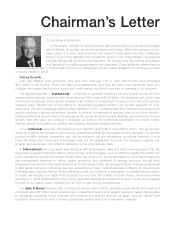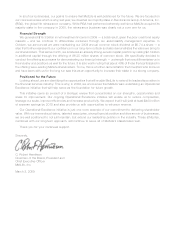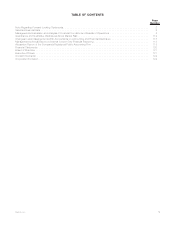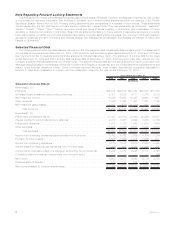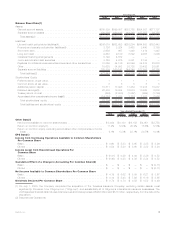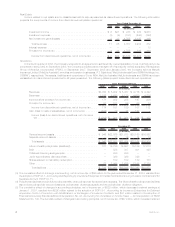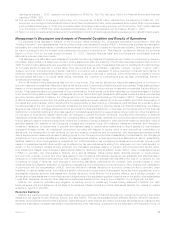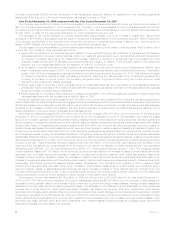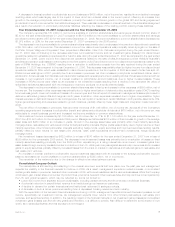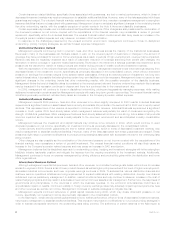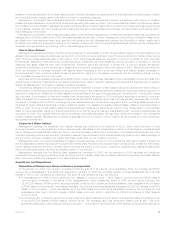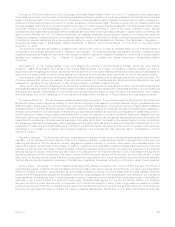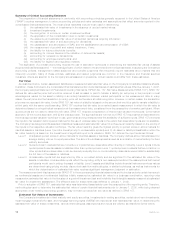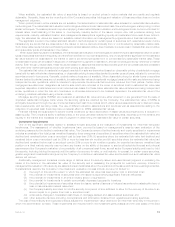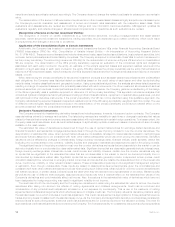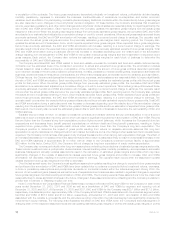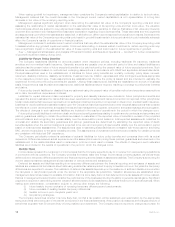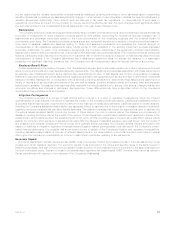MetLife 2008 Annual Report Download - page 12
Download and view the complete annual report
Please find page 12 of the 2008 MetLife annual report below. You can navigate through the pages in the report by either clicking on the pages listed below, or by using the keyword search tool below to find specific information within the annual report.sensitive to interest rates and other related assumptions. Adverse changes in key assumptions for interest rates, exchange rates, mortality
and morbidity levels or lapse rates could lead to a need to strengthen reserves.
Management continues to take a disciplined approach toward expense management, however, management will continue to invest in
infrastructure and distribution improvements where such spending will enhance growth. The unusual financial market conditions may cause
an increase in DAC amortization. Management believes that the ability to deliver quality risk & protection and retirement & savings products
to the markets, coupled with the Company’s financial strength and strong risk management expertise, will help achieve continued growth in
this challenging environment.
Management continues to take a disciplined approach toward expense management. Operational excellence initiatives undertaken by
management in 2008 and planned for 2009 will create expense efficiencies, however, management will continue to invest in infrastructure
and distribution improvements where such spending will enhance growth. Management believes that the ability to deliver quality risk &
protection and retirement & savings products to the markets, coupled with the Company’s financial strength and strong risk management
expertise, will help achieve continued growth in this challenging environment.
Auto & Home Outlook
Management expects premiums for the Auto & Home segment to grow slightly in 2009. The key sales triggers of new and existing home
sales and auto sales dropped precipitously during 2008, contributing to large declines in new Homeowner and Auto policies written during
2008. However, these declines began to slow late in 2008. New business sales are expected to rebound modestly for both Auto and
Homeowners, assuming overall economic conditions improve, particularly as credit availability returns, and as a combination of various
marketing and sales initiatives have been implemented. Retention ratios are expected to remain flat, or improve slightly, as specific
underwriting initiatives to control exposures to catastrophe events were completed in the fourth quarter of 2008. Net premiums written for
2009 are expected to increase modestly with slightly larger increases in Auto premiums written and slightly smaller increases in
Homeowners and other. A portion of this increase is expected to result from increases in exposures with the remaining change coming
from increased average premium per policy.
Net investment income is also expected to be slightly lower in 2009, as previously discussed in the consolidated outlook, and cash from
operations and maturing investments is reinvested at slightly lower rates. In addition, Management expects the expense ratio to decline
slightly as Management continues to manage operating expenses.
Underwriting margins for both Auto and Homeowners are expected to remain under pressure as some carriers have been willing to
accept higher combined ratios in an attempt to grow written premium. Auto results benefited primarily from lower severities during 2008. A
reduction in miles driven, initially tied to higher gasoline prices and later in the year to the general economic slowdown, contributed to these
improvements. A continuation of the trend towards lower frequencies is expected for 2009 with higher severities expected to more than
offset the gains from frequencies. Management believes this will result in a slightly higher loss and loss adjusting expense ratio for 2009,
compared to the same ratio for 2008, excluding prior year loss development. Homeowner margins for 2008, excluding catastrophes, were
impacted by higher claims frequencies, primarily related to greater non-catastrophe weather-related losses, offset by lower severities. In
2009, a return to more normal weather patterns is expected and management believes will result in lower frequencies in 2009 partially
offset by higher severities, resulting in a small expected drop in the Homeowner loss and loss adjusting ratio, excluding catastrophes, as
compared to 2008. The unusual financial market conditions, previously discussed, will also likely cause an increase in the Company’s
pension-related expense. Management continues to aggressively look for ways to control costs in all other areas so it may maintain an
appropriate expense ratio.
Corporate & Other Outlook
Management believes the investment and capital markets may continue to be turbulent in 2009, which would continue to exert
downward pressure on net investment income, as previously discussed in the consolidated outlook, and earnings on excess surplus
equity. Management expects that investment income could be adversely impacted by a continuation of increased liquidity levels due to the
uncertain operating environment and lack of suitable investment opportunities Current liquidity levels may position us to take advantage of
any economic recovery, mitigating the impact that these levels have on net investment income.
Management does not expect a significant increase in interest expense. A portion of the Company’s debt has a variable interest rate
and the associated interest expense will fluctuate with market rates. However, this expense has a corresponding investment that is also
tied to variable rates and therefore, generally should minimize the impact to net income. In addition, settlements for asbestos claims and
other potential legal claims may have an adverse impact on net income.
Management expects that the MetLife Bank acquisitions completed in 2008 will be accretive to 2009 earnings with additional
investment income and higher premiums, fees, and other income, partially offset with increased interest and operating expenses. MetLife
Bank could be impacted by changes in the residential loan market.
Acquisitions and Dispositions
Disposition of Reinsurance Group of America, Incorporated
On September 12, 2008, the Company completed a tax-free split-off of its majority-owned subsidiary, RGA. The Company and RGA
entered into a recapitalization and distribution agreement, pursuant to which the Company agreed to divest substantially all of its 52%
interest in RGA to the Company’s stockholders. The split-off was effected through the following:
• A recapitalization of RGA common stock into two classes of common stock — RGA Class A common stock and RGA Class B
common stock. Pursuant to the terms of the recapitalization, each outstanding share of RGA common stock, including the
32,243,539 shares of RGA common stock beneficially owned by the Company and its subsidiaries, was reclassified as one share
of RGA Class A common stock. Immediately thereafter, the Company and its subsidiaries exchanged 29,243,539 shares of its RGA
Class A common stock — which represented all of the RGA Class A common stock beneficially owned by the Company and its
subsidiaries other than 3,000,000 shares of RGA Class A common stock — with RGA for 29,243,539 shares of RGA Class B
common stock.
• An exchange offer, pursuant to which the Company offered to acquire MetLife common stock from its stockholders in exchange for all
of its 29,243,539 shares of RGA Class B common stock. The exchange ratio was determined based upon a ratio — as more
specifically described in the exchange offering document — of the value of the MetLife and RGA shares during the three-day period
9MetLife, Inc.


